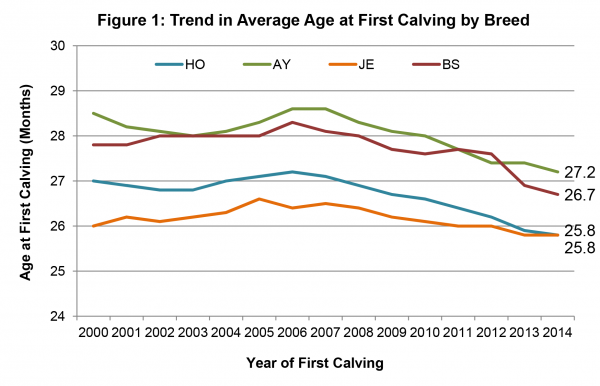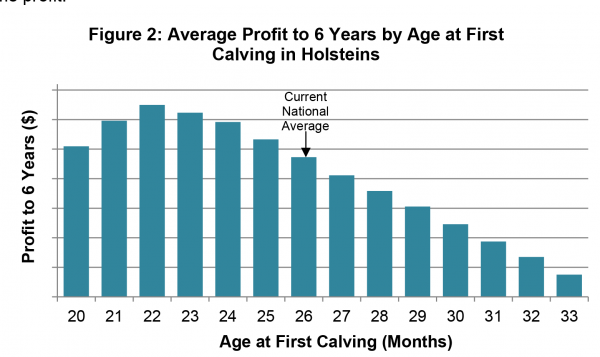Whether you’re milking 50 or 500 cows, heifer rearing represents a significant cost to any dairy operation – one that is typically second only to feed costs. What’s more, a heifer spends her first lactation paying for herself, generally not making you money until second lactation. Research has shown that the single most important factor influencing heifer rearing costs is age at first calving. Using cow profitability data, CDN examined the influence of age at first calving on lifetime profit in the four breeds of largest population in Canada.
Average Age at First Calving – How are we doing?
Trends in age at first calving are shown for Holstein, Ayrshire, Jersey and Brown Swiss in Figure 1. From around 2003 to 2006 there was a slight increase in the average age at first calving for all breeds. This was likely associated with border closures due to BSE, leading producers to wait longer to calve heifers due to an industry-wide oversupply of cows. Since this time, however, the average age at first calving has been decreasing steadily in all breeds. From 2006 to 2014, the average first calving age in Holsteins has dropped 1.4 months to the current average of 25.8 months. Interestingly, this is the same average age at first calving for Jerseys – a breed that reaches puberty one to two months earlier than the other breeds represented. In general, age at first calving is higher in the Ayrshire and Brown Swiss breeds, which average 27.2 and 26.7 months, respectively.

Age at First Calving and Profitability
Using DHI cow profitability data, CDN calculated profit to six years of age for a subset of roughly 690,000 Holsteins, 17,000 Jerseys, 17,500 Ayrshires and 4,000 Brown Swiss cows born from 2005 to 2008. These profit values take into account rearing cost, cow income and cow expenses. A cut-off of six years of age was used as it proved to capture each cow’s ability to survive through multiple cycles of reproduction, health, functional conformation and production – an imperative feature when looking at lifetime profitability.
Figure 2 shows how average profit to six years varies based on the age at first calving for Holsteins. As mentioned above, the national average first calving age for this breed currently sits at around 26 months. However, the data suggests that 22 months of age is the ideal time for Holstein heifers to calve in order to maximize their future lifetime profitability. Interestingly, and in accordance with research, calving Holstein heifers before 22 months contributes to decreased total lifetime profit.

The most profitable age at first calving may differ to some degree between breeds. For example, the analysis reveals that the most profitable first calving age for Holstein and Jersey is 22 months whereas for Ayrshire and Brown Swiss, it is 23 months (Table 1). What also varies by breed is the amount of extra profit per cow to be gained by decreasing the age at first calving from the current breed average to the most profitable age. For example, the amount of lifetime profit lost due to calving one typical Holstein heifer at 26 months compared to 22 months amounts to $880, on average. Assume a 100 cow herd calves 30 replacements per year, most of them at 26 months. If the same herd calved even 10 of the 30 replacements at 22 months instead of 26 months, the increased profit to six years for the ten animals that calved earlier would amount to nearly $9,000!
While all breeds could benefit from reducing their average age at first calving, the greatest benefits could be reaped by the Brown Swiss breed. Of the four breeds studied, the average first calving age is the highest for Brown Swiss and Ayrshire heifers at 27 months. Profitability in Brown Swiss, however, is more negatively impacted by a higher age at first calving. Calving Brown Swiss heifers at 23 months, as opposed to 27 months, could lead to an average profit gained of nearly $1,400 per animal.

The main advantages of lowering age at first calving include reducing rearing costs as well as reducing the amount of time in which the heifer is a drain on farm resources. Disadvantages of lowering the average age at first calving may include a reduction in first lactation milk yield. However, research has shown that despite this possible reduction in first lactation, production per year of herd life is typically increased by lowering the age at first calving. In addition, while the first lactation may be influenced by younger calving ages, future lactations, longevity and health are not, as long as first calf heifers freshen at an adequate weight.
Since each dairy operation has its own set of unique management and environmental conditions, it may not be possible for all herds to attain one industry-wide goal for age at first calving. This, however, does not mean that we should not work towards shorter rearing periods by calving heifers earlier – clearly there is profit to be made in doing so. Work with your herd veterinarian to assure you’re meeting defined targets for age at first calving that optimize profitability and are in line with your operations specific management needs.
Source: Canadian Dairy Network









